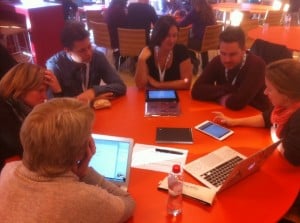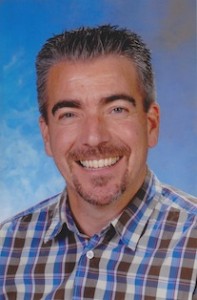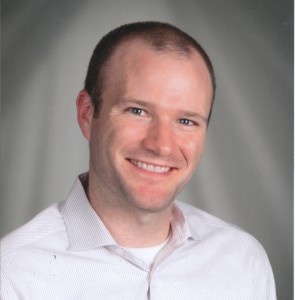 In an age of 24/7 connectivity, and more and more people tethered to their devices, there is this growing feeling by many of the concept of a disconnect with connectivity with your immediate surroundings. This of course is different for everyone, and yes we have transitioned to a world were our respective digital ecosystems and grids play a growing role in our workflow and lives. That said, the people we connect with, collaborate and share through these digital ecosystems and grids are important and provide wonderful learning opportunities face to face in conference settings or virtually through our social media tools.
In an age of 24/7 connectivity, and more and more people tethered to their devices, there is this growing feeling by many of the concept of a disconnect with connectivity with your immediate surroundings. This of course is different for everyone, and yes we have transitioned to a world were our respective digital ecosystems and grids play a growing role in our workflow and lives. That said, the people we connect with, collaborate and share through these digital ecosystems and grids are important and provide wonderful learning opportunities face to face in conference settings or virtually through our social media tools.
This month we would like to thank 4 members of our ECIS ICT committee who are stepping down as their tenure has ended and then welcome 4 new members who will begin serving on the ECIS ICT Committee in August of 2014.
ECIS ICT Committee News
This year we have the following Committee members stepping down either as their term of services has ended or they are moving to a new region, a special thank you for their support, leadership and work over their tenure on the committee, thank you!
 Chelsea Woods is currently a Technology Integration Specialist and Student Information Systems Coordinator at the Anglo American School of Moscow, where she has worked for the past 5 years. She is leaving the region in July for a new post as Technology Director at the International School of Phnom Penh.
Chelsea Woods is currently a Technology Integration Specialist and Student Information Systems Coordinator at the Anglo American School of Moscow, where she has worked for the past 5 years. She is leaving the region in July for a new post as Technology Director at the International School of Phnom Penh.
 Mariam Mathew is the High School Technology Coordinator at The American School in London. Originally from Canada, she has worked in California and New York, teaching Science, Mathematics and English. She has been a member of the ECIS ICT Committee for the past few years and supported the ECIS ICT conference at ASL in 2009.
Mariam Mathew is the High School Technology Coordinator at The American School in London. Originally from Canada, she has worked in California and New York, teaching Science, Mathematics and English. She has been a member of the ECIS ICT Committee for the past few years and supported the ECIS ICT conference at ASL in 2009.
 Leah Treesh served on the ECIS ICT Committee from 2011 – 2013. As the ECIS iTunes U consultant, part of Leah Treesh’s role includes helping support schools in beginning to utilise and publish with ECIS iTunes U. She also works with them after publication with any help needed along the way. Additionally, Leah also is the Senior School Learning Technologies Teacher at Munich International School. Privately, Leah also teaches master’s technology integration courses through SUNY and conducts onsite workshops for teachers, administration and staff concerning learning and objective-focused technology usage in schools. Feel free to contact her at Leah.Treesh(at)1to1LT.com.
Leah Treesh served on the ECIS ICT Committee from 2011 – 2013. As the ECIS iTunes U consultant, part of Leah Treesh’s role includes helping support schools in beginning to utilise and publish with ECIS iTunes U. She also works with them after publication with any help needed along the way. Additionally, Leah also is the Senior School Learning Technologies Teacher at Munich International School. Privately, Leah also teaches master’s technology integration courses through SUNY and conducts onsite workshops for teachers, administration and staff concerning learning and objective-focused technology usage in schools. Feel free to contact her at Leah.Treesh(at)1to1LT.com.
 John Mikton currently Director of Information Technology at the International School of Prague will be moving in August to the Inter-Community School Zurich, Switzerland joining the Senior Leadership Team as Director of eLearning. John has served for 6 years as Chair of the ECIS ICT Committee. Current Committee member Alan Preis, Director of Technology and 21st Century Learning at Atlanta International School
John Mikton currently Director of Information Technology at the International School of Prague will be moving in August to the Inter-Community School Zurich, Switzerland joining the Senior Leadership Team as Director of eLearning. John has served for 6 years as Chair of the ECIS ICT Committee. Current Committee member Alan Preis, Director of Technology and 21st Century Learning at Atlanta International School
Please join us in welcoming our 4 new ECIS ICT Committee Members who will join August 2014.
Sarah Woods is the IT Director and Secondary IT Integration Coach at Pechersk School International in Kiev, Ukraine, and has worked in both schools and the IT industry. She holds an MS Ed in K-12 Technology Integration and is a Google Certified Trainer. She unwinds by teaching yoga and traveling with her teenager.
 Aaron Tyo-Dickerson is a Middle School IT teacher at the American School of The Hague. Aaron is in his eighth year at ASH, where he is also responsible for administering Google Apps for Education and Moodle, which are two of his passions. He also enjoys exploring new educational developments in IT: 3D designing (and printing), programming with Scratch and Python, and real-world creation with Arduinos and MaKey MaKeys.
Aaron Tyo-Dickerson is a Middle School IT teacher at the American School of The Hague. Aaron is in his eighth year at ASH, where he is also responsible for administering Google Apps for Education and Moodle, which are two of his passions. He also enjoys exploring new educational developments in IT: 3D designing (and printing), programming with Scratch and Python, and real-world creation with Arduinos and MaKey MaKeys.
Kimberly House: I am the educational technology specialist for the primary school at Bavarian International School in Munich, Germany. I’ve been in my role at the school for almost 10 years. I’m passionate about all things technology related and especially learning together with children and teachers.
 Seth Hubbert Director of Academic Technology French American International School, San Francisco Seth began his career in education as a Physics and Chemistry teacher in New York City, and developed an interest in the relationship between technology and student learning. He has shared his passion by serving as a technology integrationist in schools, instructing university courses, and sharing his thoughts and experiences at international conferences. Seth holds a BS in Physics from Whitworth University and MA in Education from Pace University.
Seth Hubbert Director of Academic Technology French American International School, San Francisco Seth began his career in education as a Physics and Chemistry teacher in New York City, and developed an interest in the relationship between technology and student learning. He has shared his passion by serving as a technology integrationist in schools, instructing university courses, and sharing his thoughts and experiences at international conferences. Seth holds a BS in Physics from Whitworth University and MA in Education from Pace University.Featured Contribution: Kevin J. Ruth, Ph.D. newly appointed Executive Director of ECIS starting Fall of 2014.
From Skunkworks to Connectivism: The Changing World of PD
Digital Bytes: Blended Learning/ Online Learning
Infographic History of Distance Education
The Basics of Blended Learning
Building and delivering an effective blended course
Khan Academy Is Not The Progressive Model You Are Looking For
Blended Learning & the Learner: What’s edtech got to do with it?
The Busy Teacher’s Quick Guide To Blended Learning
What I Learned by Flipping the MOOC
Blended Learning in Early Elementary at Utica Community Schools
How Do You Communicate with Your E-Learners?
Are You Making These Mistakes with Your Online Training Program?
Lessons Learned from a Blended Learning Pilot
The Advantages and Disadvantages of Blended Learning in Language Teaching
Applying the Seven Principles for Good Practice to the Online Classroom
Flipped classrooms: Let’s change the discussion
The Flipped Classroom Model: A Full Picture
The Flip: Why I Love It – How I Use It / The Flip: End of a Love Affair
Blended Learning (and Teaching) is Messy #blendedlearning
Online Learning in the Traditional Classroom
Professional Development
Google Apps Events
Find out about a Google Apps for Education event in your area.
Upcoming Google in Education Summits produced in partnership with Google in Education:
Full schedule of events and locations
http://www.appsevents.com/
Flat Connections Conference – Sydney, Australia June 18-20, 2014
The Flat Connections Conference is a unique event that includes students and educators to envision the future of education and of learning communities as
they use leading technology tools such as wikis, blogs, social networking and digital storytelling.
ISTE Conference – Atlanta, Georgia USA June 28 – July 1, 2014
The ISTE Conference will be held in Atlanta this year and will feature hundreds of sessions on the theme “Connected learning, connected world”.
They are gathering input on keynote speakers for this year, feel free to submit your suggestions at https://www.isteconference.org/2014/program/keynote.php.
Information about registering for the ISTE Conference is available here: https://www.isteconference.org/2014/attend/.
Your words, your input…..
Please remember your links, your thoughts, your resources, your conferences/events are important to this blog if you have something you wish to have featured drop us a note jmikton@isp.cz a week before the first day of the month
have a good month

